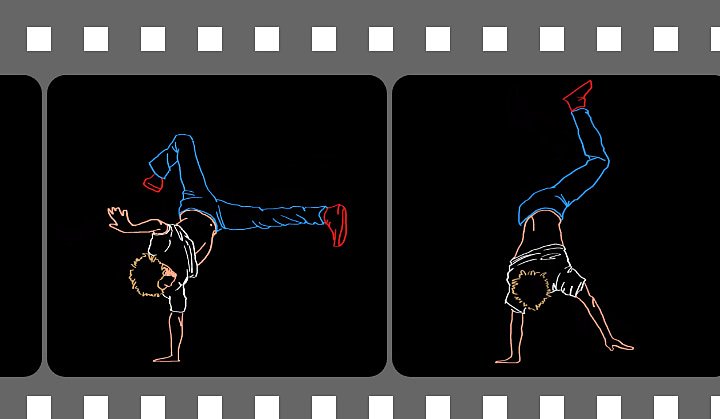P1
I am going to discuss the techniques used for different forms of animation, which include line drawing, cel drawing, rotoscoping and 2D/3D animation. I will evaluate and explain each of them and include what techniques are used and include examples of animations previously made with this.
Line drawing
Line drawing animation is a technique where images are drawn using basic brush or pen strokes that can vary in thickness and angle to create different forms of lines and depth and texture, and done frame by frame to create motion.
The time it takes to animate a frame of line drawing depends on the complexity and style of the art. For a simpler drawing with little detail, it can take as little as two minutes to sketch the lines. For more detailed art it could take up to twenty minutes or longer to make sure every line is to the artists standards and shows the movement accurately. This timeframe also considers factors like planning and concepts for the final result.
Recording or filming line drawing animations may involve using software like Adobe Animate to digitise and sequence the drawings. Job opportunities in this field include film, television, advertising, and game design, with roles such as animator, storyboard artist, and animation director. In the UK, salaries for line drawing animators can range from £20,000 to £40,000 annually for entry to mid-level positions, while experienced animators and directors can earn upwards of £60,000.
Essential skills for success in this field include strong drawing abilities, an understanding of motion and timing, proficiency with animation software, and an eye for detail.
Cel animation
This is very similar to line drawing. Cel drawing animation is a traditional technique where individual frames are hand-drawn on transparent sheets (cels) and then photographed in sequence. The animation process involves creating detailed key frames, drawing in-between frames, transferring these drawings to cels, and finally painting them before photographing each one against a background.
This intricate workflow can make cel animation time-consuming, often requiring several months to complete a short film depending on its complexity. Recording or filming the animation involves photographing each cel in sequence to create the illusion of movement, typically using a multi-plane camera setup to add depth.
Job opportunities in cel animation exist in film/TV studios and advertising agencies, with roles such as animator, clean-up artist, and background artist. In the UK, entry-level animators can expect to earn between £18,000 and £25,000 annually, while experienced professionals might earn between £35,000 and £55,000, with top-tier positions earning higher salaries.
Key skills for cel animators include decent drawing abilities, an understanding of movement and timing, attention to detail, and proficiency with both traditional and digital animation techniques.
Rotoscoping
Rotoscoping animation is a technique where animators trace over live-action footage frame by frame. It can be time-consuming due to the detailed work required for each frame. The process begins with recording live-action sequences, which are then projected frame by frame onto a drawing surface or directly into animation software, where animators trace over the footage to create realistic motion.
This method can take several months to complete even short sequences, depending on the complexity and level of detail required.
Job opportunities for rotoscope animators are mainly in film and television production, advertising, and video game development, with roles such as rotoscope artist, animation supervisor, and visual effects artist. In the UK, salaries for rotoscope artists typically range from £20,000 to £30,000 for entry-level positions, while experienced professionals can earn between £35,000 and £50,000, with senior roles potentially with higher pay.
Essential skills for rotoscoping include an eye for detail, strong drawing skills, proficiency with animation and compositing software like Adobe After Effects, and a solid understanding of motion and anatomy.
2D/3D animation
2D/3D animation is a versatile and dynamic field with varying factors affecting the time needed to complete a project. 2D animation typically involves creating characters and scenes using digital tools like Adobe Animate, while 3D animation entails modelling characters and environments in software such as Blender before animating them.
The length of time to animate varies greatly depending on the complexity of the project, with simple animations taking days to weeks, and feature-length films potentially requiring years. The animation process for both 2D and 3D involves storyboarding, keyframe animation, and rendering, with 3D animation often requiring additional steps such as rigging and texturing.
Job opportunities in 2D/3D animation span across industries including film, television, advertising, gaming, and digital media, offering roles such as animator, character designer, modeller, and animation director. In the UK, salaries for animators can range from £20,000 to £40,000 for entry-level positions, while experienced professionals and those in senior roles can earn upwards of £60,000.
Skills essential for success in 2D/3D animation include a strong understanding of animation principles, proficiency in relevant software, creativity, attention to detail, and effective communication skills.
Stop motion
Stop motion animation is a very hands-on technique where physical objects are manipulated and photographed frame by frame to create the illusion of movement. The process involves designing and making characters and sets and positioning them in it, and then capturing each frame with a camera.
This method of animation can be very time-consuming; a single second of footage often requires 24 individual frames, meaning even short projects can take weeks or months to complete. Recording or filming stop motion animation typically uses specialised software to capture and sequence the frames, ensuring smooth and precise motion.
Job opportunities in stop motion animation are found in film and television studios, advertising agencies, and production companies, with roles such as animator, model maker, set designer, and animation director. In the UK, beginner stop motion animators can earn between £18,000 and £25,000 annually, while experienced animators and directors may earn from £30,000 to £50,000 or more.
Key skills for stop motion animators can include patience, proficiency in using animation software such as PowerDirector or Adobe Premiere Pro, and strong technical skills in model making and set design.






Comments
Post a Comment